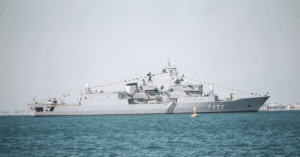Greek Navy Deploys Warships to Thwart Surge of Migrant Vessels Off Libya
Greece has decided to send navy warships to waters just outside Libya’s territory in response to a sharp rise in migrant arrivals on its southern islands, especially Crete and Gavdos.
Prime Minister Kyriakos Mitsotakis said the deployment is meant to act as a preventive step and send a strong message to human traffickers that Greece will not allow them to decide who enters the country.
Speaking during a regular meeting with President of the Republic Constantine (Costas) Tassoulas on Monday, Mitsotakis said he has asked the Minister of National Defense and the top military leaders to make sure Greek Navy ships are deployed off Libya.
Although the Prime Minister didn’t give full details about the mission’s exact role, government officials told Reuters that two frigates and one additional support vessel would leave Greek ports in the coming days.
The announcement comes after more than 730 migrants arrived on Crete and Gavdos within just 24 hours late last week. Many of them were families and children, and most had departed from the Libyan port city of Tobruk.
Migrants on these routes mostly come from countries such as Egypt, Sudan, Eritrea, and Pakistan. In some recent cases, Bangladeshi and Yemeni nationals were also among them.
The sea journey from Tobruk to southern Crete is about 180 nautical miles. It is considered one of the most dangerous migration routes in the Mediterranean. Migrants are often packed into old fishing vessels or small boats that lack food, water, or life-saving equipment. The trip typically takes more than two days, and many migrants suffer during the crossing.
According to the Greek Coast Guard, most of these boats send out distress signals once they enter Greek territorial waters. One such case involved over 350 migrants off the island of Gavdos. The boat was first spotted by Frontex, the EU’s border patrol agency, and later helped by a Hellenic Coast Guard vessel and four passing cargo ships. The rescued migrants were transferred to a temporary reception center in Palaiochora, Crete, for registration and identification.
In another recent case, over 500 migrants were rescued from similar boats near Crete and Gavdos in late May. Many of them said they had paid between 150,000 and 200,000 Egyptian pounds, about $3,000 to $4,000, to smugglers for the journey.
Greek officials say that the majority of the migrant boats are coming from northeastern Libya, mainly from Tobruk, which is controlled by General Khalifa Haftar. Despite recent diplomatic tensions, Greece plans to work with local Libyan forces in that area. Athens and Tripoli have been trying to improve relations after their ties were strained by a 2019 maritime deal signed between Libya’s government and Turkey.
The rise in migration from Libya has become more noticeable recently, as traditional routes from Turkey through the Aegean Sea have become more restricted. Local officials on Crete and nearby islands say the growing number of arrivals is putting pressure on small communities and local resources, especially during summer, which is also the busiest tourist season and important for the local economy.
Mitsotakis confirmed that he plans to raise the issue of migration and Libya at the upcoming European Council summit. He hopes the matter will be taken seriously and that the summit’s outcome will support Greece’s position.
However, experts have raised concerns about how Greek forces may engage with migrant vessels far from their own waters. This comes after the deadly Pylos shipwreck in June 2023, where at least 82 people drowned, and hundreds went missing after a boat capsized during an alleged tow attempt by the Greek Coast Guard. Greek prosecutors have charged 17 crew members from the patrol boat involved, while the coast guard has denied any wrongdoing. Survivors have claimed there was an attempted cover-up.
References: ekathimerini, greekreporter

